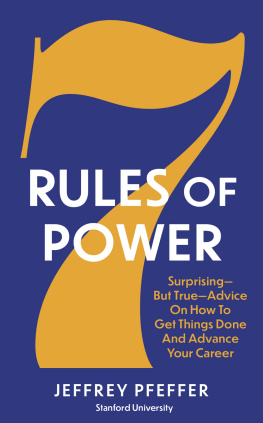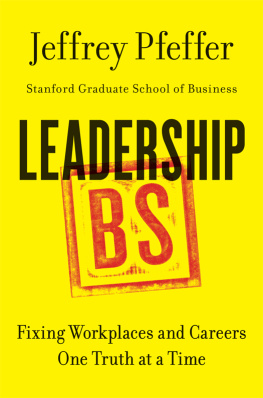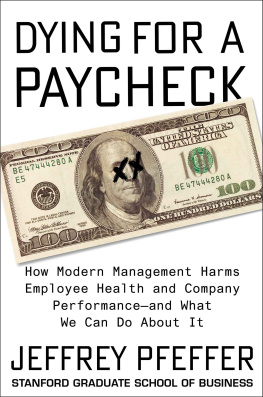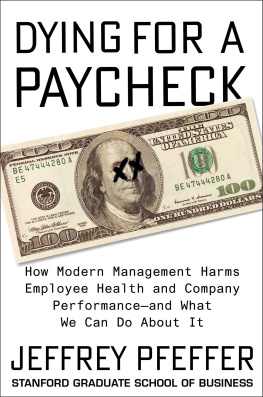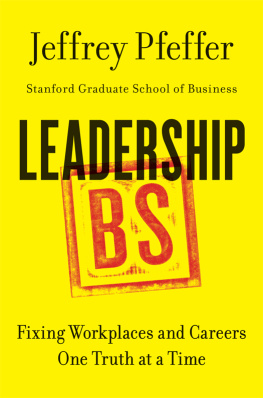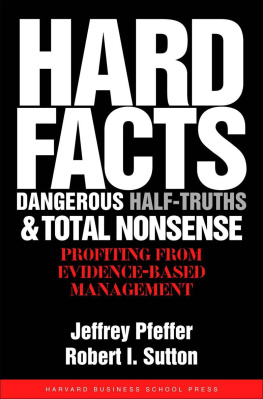Pfeffer Jeffrey - The Knowing-doing Gap
Here you can read online Pfeffer Jeffrey - The Knowing-doing Gap full text of the book (entire story) in english for free. Download pdf and epub, get meaning, cover and reviews about this ebook. year: 1993, publisher: Harvard Business Review Press, genre: Business. Description of the work, (preface) as well as reviews are available. Best literature library LitArk.com created for fans of good reading and offers a wide selection of genres:
Romance novel
Science fiction
Adventure
Detective
Science
History
Home and family
Prose
Art
Politics
Computer
Non-fiction
Religion
Business
Children
Humor
Choose a favorite category and find really read worthwhile books. Enjoy immersion in the world of imagination, feel the emotions of the characters or learn something new for yourself, make an fascinating discovery.

- Book:The Knowing-doing Gap
- Author:
- Publisher:Harvard Business Review Press
- Genre:
- Year:1993
- Rating:3 / 5
- Favourites:Add to favourites
- Your mark:
- 60
- 1
- 2
- 3
- 4
- 5
The Knowing-doing Gap: summary, description and annotation
We offer to read an annotation, description, summary or preface (depends on what the author of the book "The Knowing-doing Gap" wrote himself). If you haven't found the necessary information about the book — write in the comments, we will try to find it.
The Knowing-doing Gap — read online for free the complete book (whole text) full work
Below is the text of the book, divided by pages. System saving the place of the last page read, allows you to conveniently read the book "The Knowing-doing Gap" online for free, without having to search again every time where you left off. Put a bookmark, and you can go to the page where you finished reading at any time.
Font size:
Interval:
Bookmark:

Copyright 2000 President and Fellows of Harvard College
All rights reserved
The paper used in this publication meets the requirements of the American National Standard for Permanence of Paper for Publicationsand Documents in Libraries and Archives Z39.48-1992.
First eBook Edition: May 1999
ISBN: 978-1-5785-1124-2
From Jeffrey Pfeffer
On January 19, 1985, I met Kathleen Fowler. My life has not been the same since. She inspires, encourages, teaches, and mostof all, loves me in ways that I seldom even fully comprehend or appreciate. Without Kathleen, nothing is possible, and withher, anything is. January 19, 1985, is certainly the luckiest day of my life.
From Robert I. Sutton
As with almost everything good that has happened to me, this book never would have been written without Marina Park, my beautifuland patient love. I thank Marina for it all, especially for her constant and forgiving love, for being wiser than anyone Ihave ever met, and for our sweet and rambunctious offspring, Tyler, Claire, and Eve.
W E WROTE THIS BOOK because we wanted to understand why so many managers know so much about organizational performance, say so many smart thingsabout how to achieve performance, and work so hard, yet are trapped in firms that do so many things they know will undermineperformance. This book was inspired by several intertwined events. After the publication of two books on how to manage peoplefor enhanced organizational performance, Jeffrey Pfeffer was intrigued and puzzled to find that, over and over again, on thistopic and many others, people obviously knew what to do, but didnt do it. Pfeffer also noticed that many of his colleaguesat Stanford Business School almost invariably didnt do anything remotely related to what they taught when they found themselvesin leadership roles. Finally, he noticed that there were more and more books and articles, more and more training programsand seminars, and more and more knowledge that, although valid, often had little or no impact on what managers actually did.
So, it was clear that knowing what to do was not enough. It was clear that being smart was not enough to turn knowledge intopractice. It was evident that reading, listening to, thinking, and writing smart things was not enough. Pfeffer was takenwith this problem because, while it is obvious and pervasive, and there is no doubt it is important, there is precious little understanding about what causes it or how firmsovercome it. He suspected the problems were largely in organizational practices, not individual psychology, but he neededmuch more evidence. So he decided to launch an intensive long-term research effort to discover what prevented organizationsthat are led by smart people from doing things that they know they ought to do.
This was, and is, an unstructured and messy question. There are relevant bodies of literature and ideas, but it was clearthat the only way to explore what we came to call the knowing-doing gap was to use both qualitative and quantitative fieldmethods for studying organizations. Pfeffer needed an ally who knew how to use these kinds of methods and who was equallyintrigued by this problem. So, Pfeffer enlisted the help of Robert Sutton, a friend and Stanford colleague for many years.And off we went, to learn how some organizations failed to turn knowledge into action, how some succeeded, and why.
Our conviction that this is one of the most important and vexing barriers to organizational performance has been fueled throughoutthis project by the strong, and quite emotional, reactions we always get to this topic. When talking about other topics tothe engineers, managers, and executives we teach or when working with the organizations we try to help, we often make briefallusions to the knowing-doing problem. Again and again, after just a one-sentence description of the problem, people tellus (often interrupting us in the middle of our second sentence on the topic) that they already know what effective organizationsshould do and, if they dont have such knowledge, it is usually easy for them to find a book or, in the case of executivesor firms, to hire new employees or consultants to find out what they need to know. What they dont know how to do, what theyget wildly frustrated about, what makes them whine, holler, curse, moan, and even cry, is to understand why their firms sooften fail to turn this knowledge into action. This frustration has also meant they are curious, at times even desperate, to learn how other firms avoid orovercome barriers to turning performance knowledge into organizational actions. The depth of this frustration and the deepinterest we encountered everywhere about how to surmount knowing-doing gaps inspired us to press ahead throughout the four-yearprogram of research that led to this book.
We were also so devoted to this project (obsessed is probably more accurate) because our collaboration was among the mostdelightful and engaging working relationships we ever had. The mix of intellectual excitement and rollicking, ranting funwe shared during the last four years was a rare privilege. We both have extensive experience writing with collaborators, withover 100 coauthored books and articles between us. We know that the intellectual spark and joy we have shared during thisproject only happen a few times in a researchers lifetime. There were so many wonderful moments. Or at least we thought they were wonderful. The people around us probably found them silly and annoying. Hollering, arguing, and jumpingup and down in our regular brainstorming sessions. Ranting at each other during long airplane flights that seemed short becausewe had so many ideas to argue about. And, perhaps the best memory of all, an evening in September of 1997 in the Palace Hotelexecutive floor lounge in New York City, when a demanding Jeffrey Pfeffer kept pushing a grouchy and resistant Robert Suttonto develop ideas for the book. Sutton complained mightily that he was tired, he just wanted to eat, drink, and talk aboutsomething else. But an hour or so later, we had an outline that matches the chapter headings in this book almost perfectly.
We dont want to leave the impression that this project flowed easily and entailed no setbacks. On the contrary, we had lotsof failures along the way. We devoted a full year to a failed collaboration with a consulting firm (that, by the way, is inthe knowledge management business) that tried mightily, but proved unable, to implement a study of the gap between knowledge and action. We tried other ideas thatalso didnt work out. But once something was clearly not working, we abandoned the path quickly, stopping just long enoughto figure out what we should learn before trying something new. We never stopped to worry about how much time we had wastedand never spent one minute talking about which one of us was to blame for the last dead end. Rather, we were inspired by thesuccessful firms we studied, in which setbacks and mistakes were viewed as an inevitable, even desirable, part of being actionoriented. We heeded their advice that the only true failure was to stop trying new things and to stop learning from the lasteffort to turn knowledge into action.
There are so many people who have helped us learn. Our students in various courses at the Stanford Business School and EngineeringSchool not only did enlightening case studies, but were also real learning partners in an exploration into the messy but importantquestion of why knowing-doing gaps existed. Each of them has our heartfelt gratitude. We also want to thank every person atevery company who participated in the various quantitative and qualitative studies that we and our students did during thecourse of this project. Special thanks go to Peter B. Ashley, Dennis Bakke, Gwen Books, Charlie Bresler, Patricia Dunn, LarryFord, Betty Fried, Ben Gibert, James Goodnight, Fred Grauer, Gary High, Jeff Jefferson, David Kelley, Tom Kelley, AnnetteKyle, Diane Lumley, Charles Lynch, Dave Morthland, David Russo, Roger Sant, Steve Scammell, Elmar Toime, Burgess Winter, andGeorge Zimmer for being so generous with their time and for helping us gather useful data and insights in so many differentways. We would also like to thank our research assistants. We are grateful for the major roles that Laura Castaneda and TanyaMenon played in the field research we did for this book. We also thank Frank Flynn and Roy Vella for their research assistance.
Font size:
Interval:
Bookmark:
Similar books «The Knowing-doing Gap»
Look at similar books to The Knowing-doing Gap. We have selected literature similar in name and meaning in the hope of providing readers with more options to find new, interesting, not yet read works.
Discussion, reviews of the book The Knowing-doing Gap and just readers' own opinions. Leave your comments, write what you think about the work, its meaning or the main characters. Specify what exactly you liked and what you didn't like, and why you think so.


